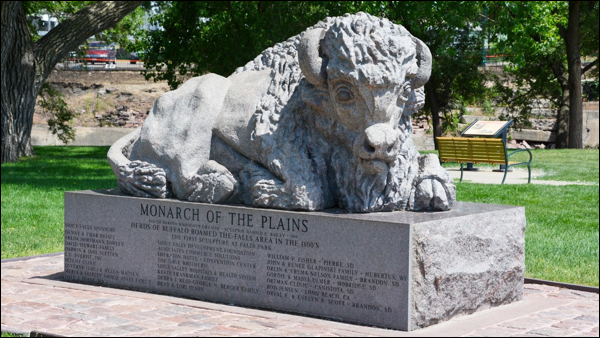An Eternal Debt of Gratitude is owed to BarnyardDawg for doing so much work on these Earthcaches to help get them published! These caches will always tie the South Dakota and Malaysia Geocaching communities together!
Monarch of the Plains is a sculpture commemorating the days when bison, commonly refered to as buffalo, were the kings of the plains and large herds roamed the area. Sculpted by Darold Bailey from a 12-ton piece of South Dakota mahogany granite, the artist estimates the finished artwork, a life size American bison, weighs in at about 7 tons.
Bailey received this commission after meeting with Sioux Falls western art gallery owner and tourism promoter Shirley Savage, who figured nothing symbolized the early great plains more than the buffalo. To fund the statue, Bailey has carved 25 smaller versions sold at 3,000 dollars each (mentioned as sponsors). The monument here at Falls Park was revealed in 1999.
The granite used for this monument was quarried at the nearby Dakota Granite Quarry at Milbank, Grant County, SD, only 115 miles (185 km) north from Park Falls.

Monarch of the Plains by Darold E. Bailey.
South Dakota Mahogany Granite
Other than diamonds, rubies, and sapphires, granite is one of the hardest natural stones. The very name suggests unyielding permanence and endurance. Granite is known for its strength, it is extremely resistant to the elements. It is however not very cooperative as far as sculpting goes.
Granite is a medium to coarse-grained intrusive igneous rock that is rich in quartz and feldspar; it is the most common plutonic rock of the Earth's crust, forming by the cooling of magma (silicate melt) at depth. The principal constituent of granite is feldspar. Both plagioclase feldspar and alkali feldspar are usually abundant, and their relative abundance has provided the basis for granite classifications. In most granite, the ratio of the dominant to the subdominant feldspar is less than two. Rocks containing less than 20 percent quartz are almost never named granite, and rocks containing more than 20 percent (by volume) of dark, or ferromagnesian, minerals are also seldom called granite. The minor essential minerals of granite may include muscovite, biotite, amphibole, or pyroxene. Biotite may occur in granite of any type and is usually present, though sometimes in very small amounts.
South Dakota Mahogany Granite is a medium to coarse-grained, granite with clear-blue quartz and traces of black biotite mica of the Precambrian period (4.6 billion years to about 541 million years ago). It's mineral composition; average orthoclase 55%, quartz 25%, plagioclase 11% and amphibole 9%. Its texture is determined by the feldspar and quartz it contains. Alkali feldspar gives granite its distinct color, ranging from pink to brown-red.
South Dakota Mahogany Granite looks great with a gloss polished surface, and the Monarch of the Plains monument provides such an example. During the polishing process a clear epoxy resin filler may be used to fill any micro fissures or tiny pitting. This process does not affect the integrity of the stone, it merely provides a smoother surface finish, but it does allow to clearly identify the quartz and feldspar present.
Sioux Quartzite
The Big Sioux river, with its tributaries, drains the major portion of the area qovered by the quartzite in South Dakota. Contrary to South Dakota Mahogany Granite, which is the topic of this EarthCache, the exposed rock here at Falls Park are Sioux Quartzite.
Sioux Quartzite is a fine to medium grained (0.125–0.5 mm), red to pink Proterozoic quartzite 2280 ± 110 Ma (2.28 billion years to about 110 million years ago). It's mineral composition varies greatly, but for this earthcache it should be mentioned that Sioux Quartzite contains between 1% and 20% quartz, with an average of 7% only. Like South Dakota Mahogany Granite, Sioux Quartzite is extremely resistant to erosion and frost resistant.
How to claim this EarthCache?
Email me the following;
1. The text "Monarch of the Plains" on the first line.
2. The answers to the following questions;
- Can you recognise the feldspar and quartz crystals? Estimate their average size.
- Describe the color of the monument (the bison, not the base). What causes this color?
- Why is South Dakota Mahogany classified as granite and the rocks at Falls Park as Quartzite?
- Given the statue is exposed to the elements, how do you see it evolve in terms of weathering?
- What is written on the bison's behind?
3. Optional task: Share your experiences and photos taken during your visit.